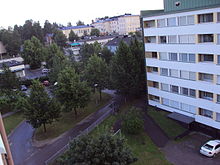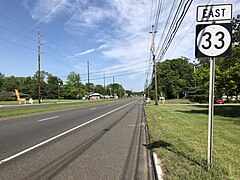
Back Voorstad Afrikaans Underburg ANG ضاحية Arabic Suburbiu AST Şəhərətrafı zona Azerbaijani Биҫтә Bashkir Ronang suburbano BCL Прадмесце Byelorussian Прадмесьце BE-X-OLD Предградие Bulgarian





A suburb (more broadly suburban area) is an area within a metropolitan area which is predominantly residential and within commuting distance of a large city.[1] Suburbs can have their own political or legal jurisdictions, especially in the United States, but this is not always the case, especially in the United Kingdom, where most suburbs are located within the administrative boundaries of cities.[2] In most English-speaking countries, suburban areas are defined in contrast to central city or inner city areas, but in Australian English and South African English, suburb has become largely synonymous with what is called a "neighborhood" in the U.S.[3] Due in part to historical trends such as white flight, some suburbs in the United States have a higher population and higher incomes than their nearby inner cities.[4]
In some countries, including India, China, New Zealand, Canada, the United Kingdom, and parts of the United States, new suburbs are routinely annexed by adjacent cities due to urban sprawl. In others, such as Morocco, France, and much of the United States, many suburbs remain separate municipalities or are governed locally as part of a larger metropolitan area such as a county, district or borough. In the United States, regions beyond the suburbs are known as "exurban areas" or exurbs; exurbs have less population density than suburbs, but still more than rural areas. Suburbs and exurbs are sometimes linked to the nearby city economically, particularly by commuters.
Suburbs first emerged on a large scale in the 19th and 20th centuries, as a result of improved rail and road transport, which led to an increase in commuting.[5] In general, they are less densely populated than inner city neighborhoods within the same metropolitan area, and most residents routinely commute to city centers or business districts via private vehicles or public transits; however, there are many exceptions, including industrial suburbs, planned communities, and satellite cities. Suburbs tend to proliferate around cities that have an abundance of adjacent flat land.[6]
- ^ Garreau, J., Edge City: Life on the New Frontier, Knopf Doubleday, 1992, p149
- ^ Caves, R. W. (2004). Encyclopedia of the City. Routledge. p. 640. ISBN 9780415252256.
- ^ Jain, Shri V. K. (30 April 2021). Applied Ecology and Sustainable Environment. BFC Publications. ISBN 978-93-90880-19-5.
- ^ "A forgotten history of how the US Government Segregated America". NPR. Retrieved 30 November 2023.
- ^ Hollow, Matthew (2011). "Suburban Ideals on England's Interwar Council Estates". Journal of the Garden History Society. Retrieved 29 December 2012.
- ^ The Fractured Metropolis: Improving the New City, Restoring the Old City, Reshaping the Region[permanent dead link] by Jonathan Barnett, via Google Books.

